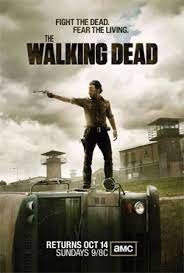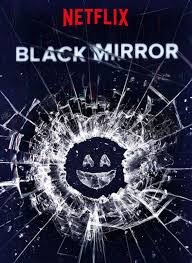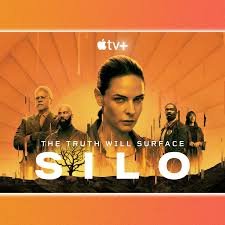My TV habits are similar to my reading habits and I mainly watch scifi, mystery, and fantasy shows. Give me mystery! Give me wonders! Give me action!
1- Lost (2004-2010)
Source: IMDB.
You have no idea how passionate (obsessed?) I was about that show. I got into it right away, started googling it frantically, completely drawn into the many mysteries of the island. A plane crashes on a mysterious tropical island where a distress radio signal has been playing on loop for 17 years, where miracles happen, where old scientific stations are buried, and a murderous smoke monster lives. Oh, and the island is also populated by mysterious 'Others' and polar bears. This show has it all: deep mysteries, science, miracles, action, humor (Sawyer nicknames and Hurley's debonair attitude!). The A-list actors are extremely talented and let's be honest, many are ridiculously hot. However, it's the back stories and character development that really get to you. The characters' stories are deep tales of loss, love, hope, and redemption. I also loved the diversity of actors and accents: British, Iraqi, Korean, Australian, etc. But... and there is a but, the finale was rather disappointing. At first, I did not even understand it and as millions of others, I was left confused and angry. When I finally got it (years later) I still thought this series did not get the brilliant finale it deserved. Still, IT IS A MUST WATCH! Six seasons available on Disney+.
2- Severance (2022-)
Source: Apple TV.
I recently heard a famous Youtuber say that he had not been that excited about a show since Lost and I can see why. The set up is very different but with this one too, the showrunners will not make it easy for you to understand and will take you down a very deep rabbit hole fueling wacko theories. Like Lost, the show is also very funny at times. Severance features the stories of employees working at a mysterious company called Lumon, which produces...eh...I don't know what. The show is called Severance because Lumon employees undergo a procedure that allows them to completely separate/severe their brain between their work self and personal self. The employees, referred to as "innies", have no idea of what their "outies" life consists of and in return, the "outies" do not know what they do at work all day. As a result, they kind of have two different personalities. Weird, right? But that's not the weirdest. The whole office complex is bizarre (sensual waffle parties? Mammalians Nurturable department?) and the company looks more like a cult than a corporation. However, the most puzzling to me is the nature of their work. The main (very likable) characters' task is to look at vintage computer screens with defiling numbers and try to identify the ones that are 'scary'. The actors also offer stellar performances (Milchik's defiant jazz dance!) Very cool retro aesthetic too. Two seasons available on Apple TV.
3- Altered Carbon (2018-2020)
Source: IMDB.
This show is based on a steam-punk scifi novel written by Richard K. Morgan. Normally, I find that books are richer than TV adaptations but, in that case, the TV series had more appeal than the novel since some of the most iconic characters, for instance, the AI butler in the form of Edgar Allan Poe, are better developed on TV than on paper. The show takes place in a future in which humans reached quasi-immortality by being able to transfer consciousnesses between bodies, a process called re-sleeving. However, only the richest can afford to be re-sleeved in their own bodies/clones while ordinary people have to buy or rent random bodies. It offers a few funny moments when a Latina grandma is re-sleeved into the body of a giant tattooed drug dealer when her family wants her back to celebrate Día de los Muertos! The story follows Takeshi Kovacs, an ex-military turned rebel hired by an immortal oligarch in order to solve...his own murder. The investigation will reveal dark secrets and the dirty doings of the powerful immortals. The show can be pretty violent at times, with lots of torture and scenes depicting sexual violence, but it challenges our conception of time, the value of life, religious beliefs, and love. The aesthetics is also on-point. The only minus is that acting is unequal but it remains a very compelling watch. Two seasons available on Netflix but season 2 was not as exciting.
4- The Handmaid’s Tale (2017-2025)
Source: Rotten Tomatoes.
This dystopian tale depicting a USA turned into a fundamentalist dictatorship is brutal and powerful, and to my great regret, it resonates a bit too much with the current political situation in the USA. The story is based on a novel by the brilliant Canadian author Margaret Atwood who recently claimed that her story was meant to be a dystopia, not a textbook… The story takes place in a not-so-distant future in which the USA has turned into a religious and environmentalist dictatorship (now called Gilead) after ecological degradation has made most women infertile. When a fundamentalist, pro-natalist political faction manages to violently overthrow the government, society is divided into strict social classes and women are confined to a domestic role and prevented from working and receiving any form of education, at the exception of a religious one. Because most women cannot bear children, the ruling class enslaves fertile lower-class women called "handmaids" who are raped and used as proxy mothers for infertile elite women and their husbands. The story follows June, one of the handmaids, whose children and husband were taken away from her and who now serves as the slave of a powerful Commander and his wife. June’s story is the ‘Tale’ as she tries to escape and reunite with her family who now live as refugees in Canada. Again, that kind of rings a bell with the current USA-Canada dynamics. Stellar performances from the actors and great aesthetics. The story line was greatly expanded from the initial book story and some of twists in the later seasons are a bit over-the-top but still worth watching. Six seasons available on Hulu.
5- True Blood (2008-2014)
Source: IMDB.
Oh man, how much I enjoyed watching this over-the-top vampire show! Based on a series of novels written by Charlaine Harris, the series takes place in Louisiana in a world where vampires came out of the closet after a vampire chemist synthesized human blood (product branded as True Blood) and freed them from the obligation of drinking fresh human blood. Yet, vampires are far from being socially accepted, and communities are deeply divided over this issue. Those who befriend and/or date vampires are called 'fang-bangers' and the social dynamics are fairly similar to the end of the racial segregation in the US south. It's no coincidence that the action takes places in the 'deep south'. The characters' heavy southern accents, the southern comfort feel, accentuated by the epic theme song added a touch to the storyline and is something I really enjoyed. The show follows the adventures of Sookie, a small-town waitress with special psychic abilities who falls in love with Bill, a local vampire. There are so many great characters in this show: Lafayette, the flamboyant cook, Jason, Sookie's not-so-smart womanizer brother, Pam, the glamorous, yet ruthless Swedish ancient vampire. This irreverent show contains a lot of humor, gore, and sex, including lots of gay sex, which is unusual for mainstream TV. That being said, it could be worth watching just to see Alexander Skarsgard as a super hot 1000-year-old vampire. Seven seasons available on HBO.
6- The Leftovers (2014-2017)
Source: IMDB.
After an inexplicable event makes 2% of the Earth's population vanish in one instant, those remaining, the 'leftovers', are left broken and in search for answers. Coming from the imagination of the creators of Lost, this shows offers a very intriguing and compelling premise, but it has been greatly underrated. The show follows members of a community in the state of New York where tensions are high. Among the many cults that emerged are the Guilty Remnants, a nihilist group whose members dress in white, chain-smoke and do not speak to anyone, not even their fellow members, whose growing popularity is destabilizing the community. The characters' journey to find meaning in life following this supernatural 'rapture' is a tumultuous journey marked by despair, doubts, illuminations, feelings of guilt, hope for redemption and answers. However, the creators do not give us many answers, and the ending is cryptic at best. The actors' performances are outstanding and the theme song is hauntingly beautiful. It is tragic, deep, and meaningful. Prepare your tissues. Three seasons available on HBO.
7- The Walking Dead (2010-2022)
Source: IMDB.
This show, adapted from a hugely popular graphic novel created by Robert Kirkman, Tony Moore, and Charlie Adlard, needs little introduction. After a zombie apocalypse, civilization has collapsed and remaining healthy humans find themselves living in a state of nature, vulnerable to elements, diseases, flesh-eating zombies, but most significantly, other humans. In this world, "man is a wolf to man", and communities that form offer a form of safety but most of them are violent, predatory, despotic, and even cannibalistic. The story spans over years and shows how the characters deal with living in constant fear, process trauma, try to make the world safer, and find hope in a hopeless place. It's an action-packed show with lots of fighting scenes and very badass characters but also moments of great sadness and despair (Think Carole and the little girl Lizzie in Season 4). By nature, the show is pretty gore and violent, so this is not for the faint of heart. Don't get too attached to characters because the death rate is really high! 11 seasons and other related off-shoot projects available on AMC.
8- Black mirror (2011-2025)
Source: IMDB.
This is not a regular TV show and it's impossible to offer a proper description of the plot. Episodes' lengths vary and each one is a standalone story but invariably, watching the show feels like a big punch in the face that warns us of the dangers of technology. Some episodes are humorous—like the wedding crasher fiasco in Season 3—or deeply moving, such as the story of lovers in a virtual paradise from the same season. However, the majority are starkly dramatic, highlighting how our dependence on technology can erode human relationships, fuel abuse, and drive radicalization. What I especially value is that these stories unfold in a world much like our own, not in some distant dystopian future, which makes them all the more relatable—and unsettling. Seven seasons available on Netflix.
9- Silo (2023- )
Source: IMDB.
Based on a trilogy of novels written by author Hugh Howey, this post-apocalyptic thriller depicts a world in which humans live in gigantic silos underground after an ecological catastrophe has made the outside uninhabitable. However, people don't actually know what happened since all history has been erased during the failed "rebellion" which took place 140 years ago. The silo is home to 10,000 humans and is governed by an elected Mayor but we quickly understand that the real power lies in the hands of the IT Department which relies on relatively low-tech methods to oversee production, manage food planning, and birth control. We follow the story of an engineer who starts asking questions about the Silo's past and governance and uncovers too many secrets. Great premise, fantastic actors, lots of action. This is the kind of show has something for everyone. Two seasons available on Apple TV.
Source: IMDB.
10- Snowpiercer (2020-2024)
Initially published as a graphic novel by French illustrators in 1982, the Snowpiercer was adapted to the cinema in 2013, and then on TV in 2020. Here too, a catastrophic climate event, which was actually an attempt to stop global warning, has frozen earth and made life impossible. The very few humans still alive are all onboard a train, the Snowpiercer, which was built as a lifeboat when the cataclysm became imminent and which is now perpetually circling the globe. The train's population is strictly divided into four classes and is profoundly unequal. While the 1st class people enjoy luxury goods (caviar and apples) and leisure activities, the 4th class people "the tailers" do the dirty work to keep the train moving while living in very poor conditions and eating exclusively protein bars made from ground-up insects. The status quo will be challenged by a series of murders that will force the collaboration between the privileged and the tailers. This show explores issues of survival, class warfare, and social justice. The distribution of actors if great and the action keep rolling. You won't be bored. Four seasons available on Netflix.
Honorable mentions
Stargate Universe (2009)
Very different from the rest of the Stargate Series and much more engaging. Scientists find themselves stranded on an ancient ship over which they have no control but the ship appears to take them on a journey to the edge of the universe. A real shame the show was cancelled after only one season.
1899 (2022)
From the German creators of the Netflix success' Dark, this show was very enigmatic from the start. Set in 1899, the show follows a group of European emigrants travelling from the UK on a steamship to start new lives in the United States. Quickly, strange events will start destabilizing the passengers and the crew. Like Dark, the show has a very oppressive atmosphere, heightened by the fact that it takes place on the confined space of a ship where nothing is like it seems. It was going to be a wild ride, but it was cancelled after one season.
Firefly (2002)
This show has a big core of supporters out there who were very upset that Fox cancelled the show after only one season. It has 8,9/10 rating on IMDB! The series takes place in the year 2517 in a world governed by an alliance of the USA and China. The story follows a group of rebels who travel from one solar system to the other, either trading or smuggling. It's funny, witty, and full of action. As a consolation price, you can watch the movie that was released in 2005. It's pretty good.















